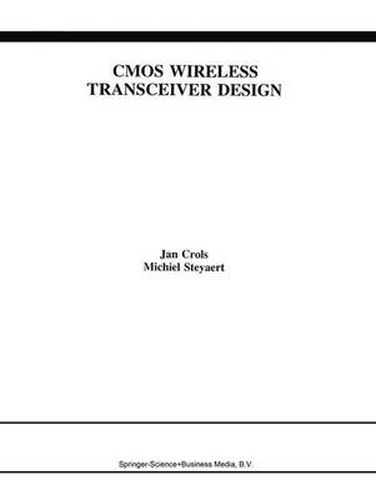Readings Newsletter
Become a Readings Member to make your shopping experience even easier.
Sign in or sign up for free!
You’re not far away from qualifying for FREE standard shipping within Australia
You’ve qualified for FREE standard shipping within Australia
The cart is loading…






This title is printed to order. This book may have been self-published. If so, we cannot guarantee the quality of the content. In the main most books will have gone through the editing process however some may not. We therefore suggest that you be aware of this before ordering this book. If in doubt check either the author or publisher’s details as we are unable to accept any returns unless they are faulty. Please contact us if you have any questions.
The revolution in wireless communications sets new requirements for transceivers (transmitter-receivers). Higher operating frequencies, lower power consumption and very high degree of integration, are specifications which require design approaches quite different from classical RF design techniques. The integratability and power consumption reduction of the digital component should further improve with the continued downscaling of technologies. This is, however, completely different for the analog transceiver front-end, the component which interfaces between the antenna and the digital signal processor. The analog front-end’s integratability and power consumption are closely related to the physical limitations of the transceiver topology and not so much to the scaling of the used technology. Providing a comprehensive treatment of the design of transceivers for use in wireless communication systems, the book overviews existing transceiver design and goes on to introduce new multi-path receiver and transmitter topologies. It also presents a formal methodology for the high-level design of transceiver architectures and fully illustrates its use in the design of a low-IF/direct upconversion GSM transceiver front-end. This text further demonstrates its practical nature by containing concluding chapters which study both the integration of RF building blocks in CMOS and the capabilities of deep submicron CMOS used in combination with the new transceiver topologies for the implementation of wireless transceiver front-ends in the 1 to 2 GHz range.
$9.00 standard shipping within Australia
FREE standard shipping within Australia for orders over $100.00
Express & International shipping calculated at checkout
This title is printed to order. This book may have been self-published. If so, we cannot guarantee the quality of the content. In the main most books will have gone through the editing process however some may not. We therefore suggest that you be aware of this before ordering this book. If in doubt check either the author or publisher’s details as we are unable to accept any returns unless they are faulty. Please contact us if you have any questions.
The revolution in wireless communications sets new requirements for transceivers (transmitter-receivers). Higher operating frequencies, lower power consumption and very high degree of integration, are specifications which require design approaches quite different from classical RF design techniques. The integratability and power consumption reduction of the digital component should further improve with the continued downscaling of technologies. This is, however, completely different for the analog transceiver front-end, the component which interfaces between the antenna and the digital signal processor. The analog front-end’s integratability and power consumption are closely related to the physical limitations of the transceiver topology and not so much to the scaling of the used technology. Providing a comprehensive treatment of the design of transceivers for use in wireless communication systems, the book overviews existing transceiver design and goes on to introduce new multi-path receiver and transmitter topologies. It also presents a formal methodology for the high-level design of transceiver architectures and fully illustrates its use in the design of a low-IF/direct upconversion GSM transceiver front-end. This text further demonstrates its practical nature by containing concluding chapters which study both the integration of RF building blocks in CMOS and the capabilities of deep submicron CMOS used in combination with the new transceiver topologies for the implementation of wireless transceiver front-ends in the 1 to 2 GHz range.